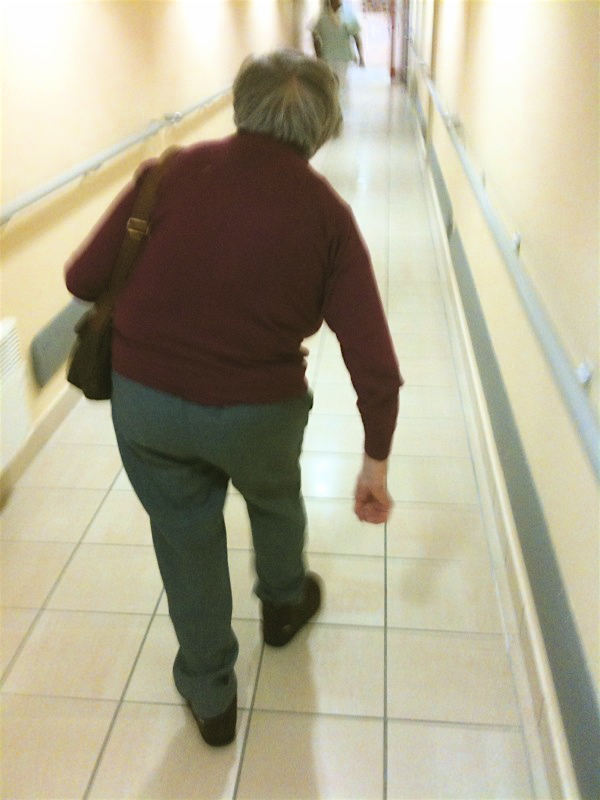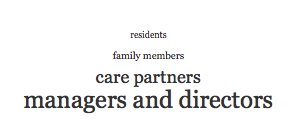In the course of my work with eldercare communities, I have become fascinated with the power differences that exist between the various groups present -- some more obvious than others. Last weekend's workshop with Max and Ellen Shupbach from Deep Democracy Institute enabled me to frame my experience within the context of rank theory.
It goes like this:
Walk into any assisted living facility or nursing home in the U.S. and you very quickly get a sense of the two most flagrant power structures at work. First is an organizational hierarchy with the director and staff in charge of dictating the daily operations, including how the care is to be delivered, by whom and at what times of the day. Caregivers are to provide care to residents following an established routine, mostly centered around ADLs (activities of daily living). There is a pre-determined time for wake-up, showering, getting dressed, eating breakfast, attending activities, getting changed, having lunch, taking a nap, attending more activities, having a snack, eating dinner and being put to bed. Caregivers get their instructions from the organization, as represented by its executive director, wellness director, nursing supervisor and activity director. In turn, residents are the passive recipients of care from caregivers.
Second is a social hierarchy with higher-paid, educated, fully physically and mentally able members of the majority class at the top. Below are the care partners, who share with their bosses the good fortune of being fully employed and healthy, while also incurring the disadvantages of being lower-paid and being most often members of minority cultures, including sometimes those with a weak command of the English language. At the bottom are the resident, who suffer from the physical and also sometimes cognitive limitations of old age, along with the loss of identity as a result of their no longer working or being perceived as active contributors to society. Organizational and social hierarchies go hand in hand. Consequences of these power structures are dramatic, as demonstrated by the outrageously high turnover rates in caregiver staff in those facilities, and also by the high incidence of behavioral symptoms exhibited by residents.

There is more than what meet the eyes, however. Other less apparent power structures also operate, and these can open the way to a better way of caring, and greater happiness for all involved. With care partners, the power lies in them being the custodians of the care. Ultimately, the quality of care comes down to whether the caregiver -- or rather, care partner -- really cares about the resident in her care. Does she feel genuinely moved to serve this person in need? Does she see him or her as a whole person? Does she respect him? Does she see her care tasks as opportunities to build a relationship with the resident? Is her heart involved? Does she feel empowered to use her whole self? This is deep democratic power in action.
Another form of such power resides in the residents themselves. One of the most powerful experiences in an elder care community lies in the witnessing of residents in various states of distress. Unattended residents, gathered in a common area and left sitting in their wheelchairs, either drooling or muttering to themselves. Otherwise, they might be pacing the hallways with blank stares, or screaming for help, or aggressing each other out of sheer frustration. You may wonder, "Why care, besides the natural urge to care for those less fortunate han oneself?" As it turns out, you should care for many reasons. Living within such a climate, day in and day out, exacts a high price from the staff in charge, in the form of systemic psychological distress, and eventually burnout. From strictly a business perspective, there is also the risk of turning away prospective families. I know this was one of the key deciding factors when looking for a community for my mother. Did the residents there appear relatively happy and well cared for? Or were they parked in the lobby with no one sit at their side? Just because they have been silenced, it does not mean that elders do not have the last word.
What this reveals is an unexplored gold mine of possibilities for elder care, where the respective powers of elders and their care partners get fully acknowledged. We need to shift the paradigm of care from solely organizational and social hierarchies to an inclusive model that takes into account all the constituents of deep democracy within the context of institutional elder care. Concretely, this means working collaboratively with care partners and residents to better understand and meet their needs. We need to invert the pyramid of care so that it looks like this:

Paying attention to the whole reality. Being mindful.
Photo credit: Marguerite Manteau-Rao